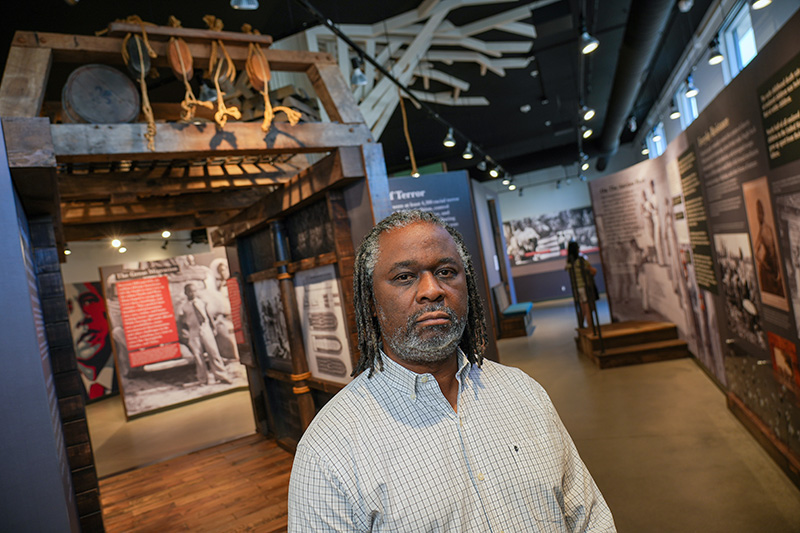Pruitt honors history and helps foster healing through leadership of America’s Black Holocaust Museum
 Over the course of his career, Brad Pruitt has been a photojournalist, filmmaker, educator and arts advocate.
Over the course of his career, Brad Pruitt has been a photojournalist, filmmaker, educator and arts advocate.
But for the past 17 years, his main job has been as caretaker of one man’s vision to help society remember our country’s difficult past in order to shape a better future for everyone.
Pruitt is executive director of the America’s Black Holocaust Museum, which was originally created in 1988 by Dr. James Cameron to explore under-told stories of the Black experience from pre-captivity to the present day. He is also one of the original community leaders who helped relaunch the museum after it closed in 2008.
Pruitt was honored with the Foundation’s 2024 Ellen Gilligan Leadership in Racial Equity and Social Justice Award for his work in shepherding the reemergence of the cultural institution that is creating space for the difficult conversations that our community and country need to have about the harmful legacies of slavery and Jim Crow in America.
“I’ve never worked on any project this long or committed as much time, energy or resources to anything,” Pruitt said. “Dr. Cameron’s vision of a more thorough investigation of our collective American history as a building block for reconciliation and ultimately healing – I think that is a vision worth investing in.”
At heart, Pruitt is a storyteller with a passion for social justice. Though he started his career in finance at the Chicago Board of Trade, he’s spent most of his life as a working artist. He’s an award-winning director, writer and producer of documentary and narrative films. Among his projects is “Guns, Grief and Grace,” a three-part series on gun violence he wrote, directed and produced with filmmaker Janet Fitch. He’s also created documentaries that focused on education, race, connections and community.
“My work tends to be focused on things that either I’m curious about, inspired by or concerned about,” Pruitt said.
Pruitt initially became acquainted with Cameron in the 1990s. Later, around 2006, he was asked by Fran Kaplan and members of a group working in collaboration with Cameron’s family to make a film about his life. Cameron was one of few known survivors of a lynching and the only one to write about the experience. Pruitt worked with a team for several years to help bring the film to life. In the meantime, the museum closed in 2008, two years after Cameron passed away.
In 2010, Pruitt raised the possibility of reopening the museum.
“We woefully underestimated the significance, the complexity and the difficulty of the journey,” said Pruitt, who has been involved with the museum’s manifestation every step along the way.
In 2012, Pruitt, Kaplan and other community leaders launched the museum’s virtual presence, which now contains more than 3,700 pages of content. Through the years he also has helped sustain and grow interest in the museum organically, thanks to community programming held in libraries, schools and universities and faith-based and other community organizations.
Pruitt also worked on the development of the museum’s physical space, located on the footprint of its predecessor, participated in creation of content for its exhibits and was there to celebrate the grand reopening in 2022 on what would have been Cameron’s 108th birthday.
“I sometimes refer to myself as an absentee filmmaker these days because I haven’t made a feature project in over a decade,” Pruitt said. “At some point I realized that the museum was my current project. This is storytelling in a different way.”
Pruitt said his unwavering commitment has as much to do with who Cameron was as the museum’s mission itself.
“The concept he had was not only brilliant but had the potential to be extraordinarily effective and impactful,” Pruitt said. “It is humbling to be a part of this legacy and to be a part of this kind of exploration of our history together.”
Over the past two years, more than 16,000 people have visited the bricks and mortar location and 500,000 visitors from 200 countries have visited its website. In 2022, ABHM was highlighted by The New York Times as one of the main reasons why people should visit Milwaukee’s Bronzeville neighborhood.
Pruitt describes the museum as one of Milwaukee’s living rooms where the community can gather, learn and exchange information.
“We really don’t have a lot of spaces in the city where people from all sectors and all backgrounds can come and feel welcomed and engage in and explore difficult subject matter,” he said.
Pruitt said there is a lot of undeveloped potential for the museum – online and in its physical space – and he’s committed to exploring that.
“It took several hundred years to create the environment we’re in,” Pruitt said. “It will take a minute to work our way through it. There’s a lot of work to do. And that is why I say the only way for me to pace myself is to spend the rest of my life doing it.”